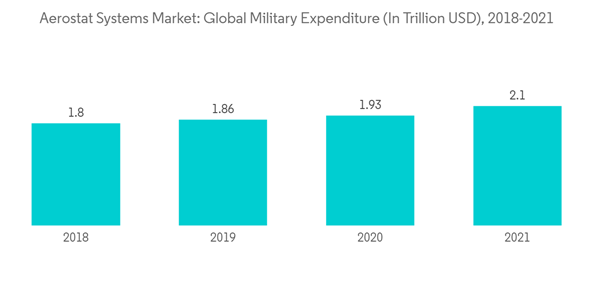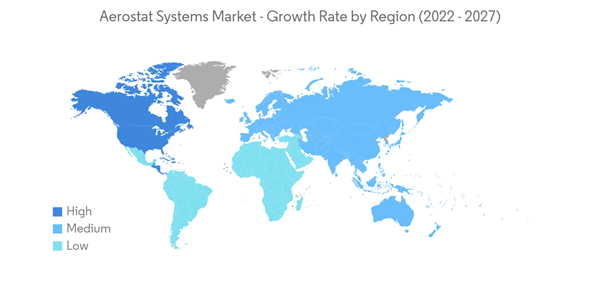The aerostat systems market is estimated to register a CAGR of more than 7% during the forecast period.
Despite the considerable impact of the COVID-19 pandemic on the global economy, the growth in international conflicts led to increased military expenditure by various countries. The global military expenditure exceeded over USD 2.1 trillion as of 2021. The rise in military spending is expected to drive investments in aerostat systems by military end users.
Factors like growing terrorism, increasing territorial tensions, and border infiltrations globally are propelling the militaries to enhance their battlefield data-sharing capabilities. Though UAVs are becoming popular for ISR missions, UAVs cannot offer continuous wide-area surveillance for several days, resulting in several countries adopting aerostats as an alternative. Aerostat systems may operate 24/7 for weeks or even months at a time, offering persistent surveillance.
Other than military applications, aerostats are becoming popular for environmental research and commercial applications, like internet connectivity. Aerostats are being used to expand LTE networks and 5G technology in remote areas at a significantly low cost and energy.
However, the aerostat systems market faces challenges and limitations for operational altitude and survivability in adverse weather conditions. These limitations are expected to challenge the market's growth during the forecast period.
Several military and law enforcement end users are considering procuring various monitoring options in the coming years. Aerostat systems are expected to be one of the viable options for procurement due to their advantage in obtaining highly accurate and real-time surveillance data at a remarkably low total cost of ownership. Furthermore, the ease of integrating advanced ISR payloads, such as electro-optical/infrared cameras, radar, and communications relays, is expected to support their procurement plans.
In March 2022, the Israeli defense ministry’s missile defense organization (IMDO) delivered the Tal Shamaim High Availability Aerostat System (HAAS) to boost the Israeli Air Force’s missile defense capabilities. The aerostat is one of the largest global aerostats, designed to carry an improved sensing system to provide detection and early warning of cruise missiles and advanced threats aimed at Israel. Such deployments are expected to bolster the prospects of the military and law enforcement segment in the future.
On the other hand, the recent decision by the US Customs and Border Protection to end the seven-year-old surveillance blimp program due to the high costs is expected to hinder the market growth in the country. In the commercial and the research segment, many aerostat manufacturers in the United States are collaborating with telecommunication service providers to provide enhanced telecommunication network quality to users. The company, Altaeros, uses aerostats called the aerial cell tower SuperTowers ST200 to provide enhanced 4G LTE networks in the United States. Aerostat systems also find applications in urban drone tracking operations to protect high-value assets. Thus, the growth in novel aerostat applications is expected to propel the growth of the aerostat market in North America during the forecast period.
Aerostat systems have immense potential for commercial application, especially in the communication category. Hence, the partnerships of aerostat manufacturers with various commercial operators are expected to increase their sales and global geographical footprint.
On the other hand, aerostat systems manufacturers are enhancing the capabilities of their existing aerostats with the integration of advanced sensors. Technologies like unmanned aerostats are expected to define the future of the aerostat industry, and players are expected to incorporate such technologies in their future products. This is also anticipated to help the companies acquire contracts from new customers and increase their market share.
This product will be delivered within 2 business days.
Despite the considerable impact of the COVID-19 pandemic on the global economy, the growth in international conflicts led to increased military expenditure by various countries. The global military expenditure exceeded over USD 2.1 trillion as of 2021. The rise in military spending is expected to drive investments in aerostat systems by military end users.
Factors like growing terrorism, increasing territorial tensions, and border infiltrations globally are propelling the militaries to enhance their battlefield data-sharing capabilities. Though UAVs are becoming popular for ISR missions, UAVs cannot offer continuous wide-area surveillance for several days, resulting in several countries adopting aerostats as an alternative. Aerostat systems may operate 24/7 for weeks or even months at a time, offering persistent surveillance.
Other than military applications, aerostats are becoming popular for environmental research and commercial applications, like internet connectivity. Aerostats are being used to expand LTE networks and 5G technology in remote areas at a significantly low cost and energy.
However, the aerostat systems market faces challenges and limitations for operational altitude and survivability in adverse weather conditions. These limitations are expected to challenge the market's growth during the forecast period.
Aerostat Systems Market Trends
Military and Law Enforcement Segment Held the Largest Market
The military and law enforcement segment accounted for a major market share, primarily due to increased demand for aerostat systems to support intelligence, surveillance, and reconnaissance missions and enhance network communications capabilities in land and sea platforms. Ground-based and shipboard aerostats are effective and affordable systems that offer continuous, wide-area surveillance and timely provision of target information. They may be used for applications including early intrusion alerts, illegal immigration monitoring, anti-terrorism, fishing activity surveillance, and smuggling deterrence.Several military and law enforcement end users are considering procuring various monitoring options in the coming years. Aerostat systems are expected to be one of the viable options for procurement due to their advantage in obtaining highly accurate and real-time surveillance data at a remarkably low total cost of ownership. Furthermore, the ease of integrating advanced ISR payloads, such as electro-optical/infrared cameras, radar, and communications relays, is expected to support their procurement plans.
In March 2022, the Israeli defense ministry’s missile defense organization (IMDO) delivered the Tal Shamaim High Availability Aerostat System (HAAS) to boost the Israeli Air Force’s missile defense capabilities. The aerostat is one of the largest global aerostats, designed to carry an improved sensing system to provide detection and early warning of cruise missiles and advanced threats aimed at Israel. Such deployments are expected to bolster the prospects of the military and law enforcement segment in the future.
North America is Expected to Dominate the Market During the Forecast Period
North America was the largest and the most dominant market for aerostat systems and is expected to lead the market further during the forecast period. The United States is the largest market for aerostat systems globally. The country is focused on using these aerostats along the borders for surveillance and investing in developing and procuring these surveillance systems. For instance, In June 2022, the US Customs and Border Protection’s (CBP) Program Management Office Directorate (PMOD) installed a 22-Meter Persistent Ground Surveillance System Aerostat in Nogales, Arizona. The aerostat is located approximately one mile north of the International Boundary with Mexico. It is expected to be operational and manned by border patrol agents 24 hours a day, seven days a week, to provide continuous aerial surveillance of the border. Such deployments are expected to drive the market in the country during the forecast period.On the other hand, the recent decision by the US Customs and Border Protection to end the seven-year-old surveillance blimp program due to the high costs is expected to hinder the market growth in the country. In the commercial and the research segment, many aerostat manufacturers in the United States are collaborating with telecommunication service providers to provide enhanced telecommunication network quality to users. The company, Altaeros, uses aerostats called the aerial cell tower SuperTowers ST200 to provide enhanced 4G LTE networks in the United States. Aerostat systems also find applications in urban drone tracking operations to protect high-value assets. Thus, the growth in novel aerostat applications is expected to propel the growth of the aerostat market in North America during the forecast period.
Aerostat Systems Market Competitor Analysis
The aerostat systems market is moderately consolidated, as few major players occupy a major share in the market. Some prominent players in the market are Lockheed Martin Corporation, TCOM LP, Raven Industries, Israel Aerospace Industries Limited, and RT LTA Systems Ltd, among others.Aerostat systems have immense potential for commercial application, especially in the communication category. Hence, the partnerships of aerostat manufacturers with various commercial operators are expected to increase their sales and global geographical footprint.
On the other hand, aerostat systems manufacturers are enhancing the capabilities of their existing aerostats with the integration of advanced sensors. Technologies like unmanned aerostats are expected to define the future of the aerostat industry, and players are expected to incorporate such technologies in their future products. This is also anticipated to help the companies acquire contracts from new customers and increase their market share.
Additional benefits of purchasing the report:
- The market estimate (ME) sheet in Excel format
- 3 months of analyst support
This product will be delivered within 2 business days.
Table of Contents
1 INTRODUCTION
4 MARKET DYNAMICS
5 MARKET SEGMENTATION (Market Size and Forecasts by Value - USD billion, 2022 - 2027)
6 COMPETITIVE LANDSCAPE
Companies Mentioned (Partial List)
A selection of companies mentioned in this report includes, but is not limited to:
- TCOM LP
- Raven Aerostar
- Lockheed
- Worldwide Aeros Corp.
- Israel Aerospace Industries Limited
- Allsopp Helikites Limited
- ILC Dover LP
- RosAeroSystems
- Lindstrand Technologies Limited
- Airborne Industries
- RT LTA Systems Ltd
- Otonom Technology
- Rheinmetall AG
- Altaeros
- CNIM
- Skydoc Systems Inc.
- Carolina Unmanned Vehicles Inc.
Methodology

LOADING...










